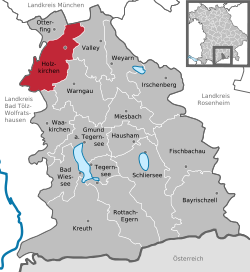Holzkirchen (Oberbayern)
| Holzkirchen | ||
|---|---|---|
|
||
| Coordinates: 47°53′N 11°42′E / 47.883°N 11.700°ECoordinates: 47°53′N 11°42′E / 47.883°N 11.700°E | ||
| Country | Germany | |
| State | Bavaria | |
| Admin. region | Oberbayern | |
| District | Miesbach | |
| Government | ||
| • Mayor | Olaf von Löwis of Menar (CSU) | |
| Area | ||
| • City | 48.33 km2 (18.66 sq mi) | |
| Elevation | 691 m (2,267 ft) | |
| Population (2015-12-31) | ||
| • City | 16,260 | |
| • Density | 340/km2 (870/sq mi) | |
| • Metro | 15,804 | |
| Time zone | CET/CEST (UTC+1/+2) | |
| Postal codes | 83607 | |
| Dialling codes | 08024 | |
| Vehicle registration | MB | |
| Website | www.holzkirchen.de | |
Holzkirchen is a market town in Bavaria, Germany. With a population of over 16,000 (2008) it is the largest town in the Miesbach district.
Holzkirchen is located on the Alpenvorland in the county of Miesbach. It was established as a Markt in the 13th century.
Holzkirchen was the location of one of the main transmitting stations for Radio Free Europe. Transmissions started in 1951 and provided the people of Eastern Europe with news from Western Europe. The transmitters had a strength of up to 250 Kilowatts. There were claims that the high-powered transmissions caused illnesses locally. There were also claims that it was so strong that locals could hear the radio programmes through their faucets. Subsequent to the relocation of RFE studios from Munich to Prague, the medium wave transmitter was shut down in 2001, following which the short wave transmissions continued on reduced power. The final transmissions were made in 2005, after which the transmission equipment was packed up to be sent to the Philippines and the masts were scrapped.
Nowadays Holzkirchen is well known as a location for pharmaceutical research and production. The European center of Sandoz and HEXAL are located in the industrial zone.
The historic church of St Laurentius is located in the town.
...
Wikipedia



